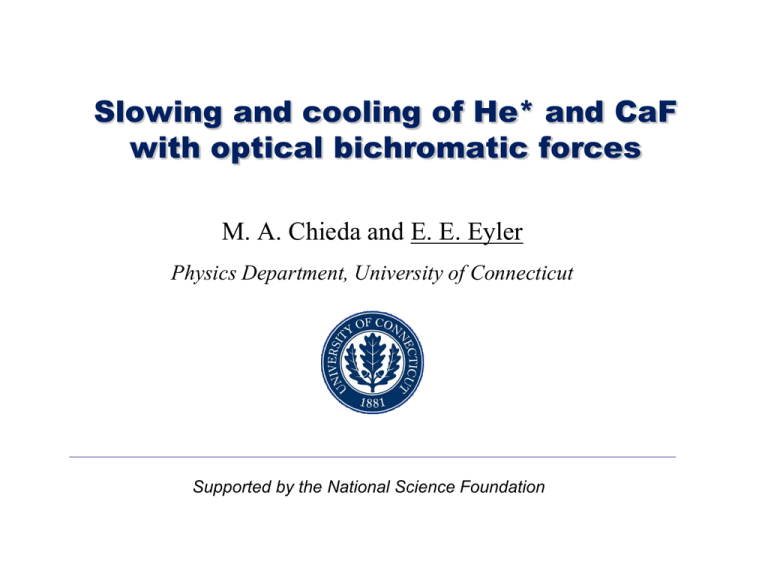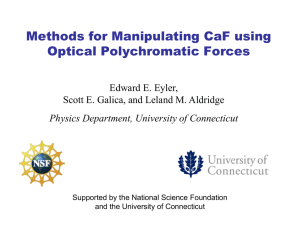Slowing and cooling of He* and CaF with optical bichromatic forces
advertisement

Slowing and cooling of He* and CaF with optical bichromatic forces M. A. Chieda and E. E. Eyler Physics Department, University of Connecticut Supported by the National Science Foundation BCF π-pulse model / / w0 w0 v • In each direction, two beams shifted by rf frequencies ± form a traveling train of beat notes with carrier w0. • Choose the optical power so that each beat note has an area of approximately , inverting a 2-level system. • Synchronized -pulses lead to coherent momentum transfer at rate / >> radiative decay rate γ=1/τ. • If relative phase = / 2, after each radiative decay the chance of excitation from the right is 0.75 Force is directional. BCF magnitude and velocity range Given two momentum transfers per stimulated cycle, FB, ideal But the atom spends ¼ time in the wrong (accelerating) cycle, so: FB DP 2 k 2 k . Dt k and thus, The left-hand and right-hand beat notes are timereversed images of one another, so the BCF: FB 2 . FRad g e • Is very tolerant of deviations from -pulses. • Is not affected by moderate Doppler shifts kv, which do not break this symmetry! • Upper velocity limit: WRabi W0 2 (kv)2 is grossly disrupted if kv ~ W0, , leading to a velocity range of Dv /k. • Has a huge range compared to Dv g /k for FRad! g Numerical solution of OBEs Force profiles are calculated for 4He, using code based on previous versions by Metcalf, Grimm, Solomon groups. Predicts a slightly larger optimum Rabi frequency than π-pulse model. For each component beam, W 3 2 vs. W 4 . The velocity range is Dv /k , as before. The velocity profile has a sharp edge, making cooling possible as atoms “pile up” against it. Effective if interaction time exceeds “BCF slowing time” of /(2 wrecoil), 5.9 m s for He*. For more on cooling, see H. Metcalf, Entropy exchange in laser cooling, Phys. Rev. A 77, 061401 (2008). Application to metastable He* atoms v w0 + kv w0 - kv For He 23S 23P at 1083 nm, if = 154g 250 MHz × 2, • Required laser power from each direction = 23.8 W/cm2. • Beat note period is / = 2 ns, much faster than t = 1/g = 98 ns. • FB = 3.1 × 10-19 N 100 FRad. • Velocity range is Δv = /2k= 135 m/s, still much smaller than beam velocity of ~1000 m/s. • Slowing time is Δt = 5.8 μ s, independent of velocity range. UConn bichromatic force decelerator for He* Bichromatic detuning δ = 2π fAOM Doppler shifts ±2Δ Microcontroller-based lab instruments • The project uses numerous homemade timing/control/frequency generation circuits. • We now use 32-bit Microchip PIC processors with a USB interface to an Android tablet for graphics and user input. • Designs include a ramp/timing generator (pictured), temperature controller, and rf frequency synthesizer/offset lock circuit. USB interface Dual 12-bit and 16-bit DACs Touch-screen tablet controls For more, see http://www.phys.uconn.edu/~eyler/microcontrollers/ , also E. E. Eyler, RSI 82, 013105 (2011). Typical results from the UConn He* decelerator Without BCF With BCF Difference • In these tests, at most 20% of the atoms within range Dv can be slowed. • Caused by small size of laser beam, needed for tests at very large detunings . M. A. Chieda and E. E. Eyler, to be published (2012), Upper limits of static BCF slowing e Non-directional! g • Results at 450 MHz are consistent with a 1-D random walk. • Mechanism 1: Cumulative dephasing due to left-right beam imbalance. Causes reversals in the force direction by ruining the time-reversal symmetry. • Mechanism 2: Phase shifts in the left-vs.-right rf beat notes weaken the force. At large , cannot avoid phase differences along beam path due to beat note length of 10-20 cm. • Both effects are predicted to be large when > 250 g! Chirped slowing of He* Initial tests: Detuning of 74g gives a velocity range of only 1.57 / k = 200 m/s, but the lasers are linearly chirped in about 20-40 m s to follow the changing Doppler shift. Apparatus for chirped helium deceleration Toptica DL100 lasers produce about 40 mW in each bichromatic beam pair without amplification, adequate for a BCF detuning of 74g or 120 MHz. AOMs To He* beam apparatus Lasers Homemade rf frequency synthesizers Frequency locking and beam conditioning Results for chirped slowing of He* Measured Simulated using F = FB / 2. Maximum usable chirp was limited by rf phase noise and other technical issues. At 300 MHz, measured slowing is by 2.84 / k = 370 m/s Simulations match well, and clearly show that efficient slowing to rest is feasible if rf phasing is improved and detuning is slightly increased. M. A. Chieda and E. E. Eyler, to be published (2012), Direct laser slowing and cooling of molecules A quasi-cycling transition is needed. OH, CH, etc. are candidates. Easiest are CaF and SrF: visible-light transitions; nuclear spin I of just ½. The DeMille group at Yale recently achieved both transverse cooling and longitudinal slowing of SrF, using radiative forces with numerous multiple vibrational and hyperfine repumping lasers. E.S. Shuman, J.F. Barry, and D. DeMille, Nature 467, 820 (2010), J.F. Barry, E.S. Shuman, and D. DeMille, PRL 108, 103002 (2012). Longitudinal slowing results from Yale • Initial beam: cryogenic SrF beam source with v ~ 140 m/s, using He buffer gas. • Velocity is reduced by 40-60 m/s for red detuning of 260 MHz At least 104 photons are scattered by the radiative force. • Some molecules are slowed to 50 m/s. • Estimated velocity profile of the radiative force is shown as gray hatched area. Figure from J.F. Barry, E.S. Shuman, and D. DeMille, Phys. Rev. Lett. 108, 103002 (2012). Level scheme for cw slowing of CaF Both AX and BX in CaF are near-cycling transitions: rotationally closed, with FranckCondon factor of 0.99 for the (0-0) band of AX, and 0.999 for BX! The BCF avoids excessive radiative cycling: system is in the upper state ~1/7 of the time, and there are many BCF cycles per radiative cycle. If = 250 MHz × 2 (30×natural width), needs I ~ 60 W/cm2; velocity range is Dv = 150 m/s. 2 + J =1/2, F =0,1, (+) parity 606.3 nm or 530.96 nm J =3/2 X 2 , N =1 + J =1/2 Remaining Problem: Hyperfine structure and unresolved m sublevels. A 21/2 or B , N =0 F =2 F =1 48.9 24.2 F =0 -22.6 F =1 -98.3 MHz Finding an effective two-level system The N 0 N 1 transition is rotationally closed, but has several (F, mF) levels that cannot be optically pumped with circular polarization. Three approaches are possible: (1) Live with it. The BCF is zero or positive for every level. If rapid level mixing is maintained, the net force is still large. (2) Alternate BCF pulses (s - polarization) with optical pumping (s +) for state selection. (3) Switch to the Q11(0.5)/RQ21(0.5) branch (shown). A rotational repump laser is needed, but the four transitions shown all have the same line strength. For BX the upper state also has a J =3/2 component, but the spinorbit splitting of 2.06 GHz is >> . 2 + A 21/2, or B , F =1 J =1/2(–), N =0 F =0 F =1 m = -1 0 1 30.5 MHz X 2 , N =0, J =1/2 + F =0 0 -91.5 MHz Estimated BCF parameters for CaF Bichromatic detuning Deceleration / 2 a 250 MHz 1.4 × 106 m/s2 Bichromatic velocity range Dvb 150 m/s BCF slowing time Tb 108 m s Loss time Tloss 14 m s Loss-limited velocity range Dvloss 19.4 m/s Optimal irradiance Ib 60 W/cm2 Ratio of BCF to rad. force Fb : Frad 12.4 These values are for Q11(0.5) of AX without vibrational repumping.With one repump laser, Dvloss exceeds Dvb. For BX , Dvloss is larger by at least a factor of five. Experimental tests now underway! For more details on AX, see M. A. Chieda and E. E. Eyler, Phys. Rev. A 84, 063401 (2011). Test of BCF in a multi-level system: He 2S-2P with pi-polarized light 23P, 23P, J’=1 J’=2 -2 -1 0 +1 -1 0 +1 1 10 2 15 1 6 23S, J=1 -1 Transition Strengths in units of f1,2=0.17974 +2 1 10 1 5 1 6 0 f1,1=0.29958 +1 𝜉′𝐽′ 𝑑 𝜉𝐽 2 from NIST Atomic Database BCF in a system with multiple mj levels Population (arb) 1.0 s-polarized light, = 2*300MHz 0.8 0.6 0.4 0.2 0.0 -0.2 600 800 1000 1200 1400 1600 1800 2000 Velocity (m/s) Population (arb) 1.0 0.8 -polarized light, = 2*300MHz 0.6 0.4 0.2 0.0 -0.2 600 800 1000 1200 1400 1600 1800 2000 Velocity (m/s) From M. A. Chieda and E. E. Eyler, Phys. Rev. A 84, 063401 (2011). Low-cost 531 nm BCF lasers DL100 Main BCF laser: Toptica DL100 external-cavity diode laser at 1062 nm, amplified to ~1.5 W with a tapered amplifier laser diode, then doubled in a homemade resonant cavity. Under construction. 100-250 mW expected at 531 nm. Repump laser: Photodigm DBR at 1062 nm (a one-piece 100 mW tunable single-mode cw laser!) with a PPKTP waveguide doubler All components have arrived. 5-15 mW expected at 531 nm. PPLN B 2 + v=1 v=0 531 A 2 585 605 X 2 + X 2 + Detection laser: 585 nm cw dye laser (existing). TA (1.5W) BCF Detection Summary • The BCF can be up to 300 times larger than the radiative force, with a much wider velocity range. • Upper limit is set by by dephasing of Rabi cycling and of rf beat notes between the counterpropagating beams. • Chirped BCF slowing can slow a He* beam to rest. • For molecules, limitations due to “dark state” decay are reduced greatly. • CaF has two near-cycling systems; BX will be used for tests. Expect Dv > 150 m/s with one repump. Single-pulse BCF deflection or slowing • Use large detunings with long-pulsed lasers (Nd:YAG or flashlamp-pumped)? • No repumping: just use the force available from a single pulse, comparable to a single radiative period (~19 ns × 14/3 for CaF A-X). • Applicable to deflect a selected quantum state in nearly any molecular beam. • Acceleration of CaF with a detuning of 2.1 GHz (250 grad) is 2.3×107 m/s2, yielding Dv = 4 m/s for one radiative period. Beam imbalance may constrain use of larger detunings. • Short interaction length circumvents rf phase problems. Cooling and slowing atoms by photon recoil Laser |b Δ𝐸 = ℏ𝜔 Δ𝑝 = ℏ𝑘 𝑘, 𝜔𝐿 |a Scattered photon FRad kg sc In saturation, g sc g 2, and FRad k g 2 Typically, v = 1–9 cm/s per photon scattered. g = 1/t Metastable helium energy levels 2 3 P0 29.617 GHz 2 3 P1 2 3 P2 2.2912 GHz 1083 nm 2 3 S1 𝜏 = 8000 s t 98 ns g 1.62 MHz 2 I sat 0.17 mW/cm 2 2 I Bich 62.6 nm 11S0 3I sat , each beam. g References [1] M. Partlow, Bichromatic Collimation to Make an Intense Helium Beam (2002). [2] Cohen-Tannoudji et al., Atom-Photon Interactions (Wiley Interscience, 1992). [3] P. Straten and H. Metcalf, Laser Cooling and Trapping (Springer 1999). [4] R. Grimm, J. Soding, Y. Ovshinnikov, Opt. Lett. 19, 658 (1994). [5] L. Yatsenko and H. Metcalf, Phys. Rev. A 70, 063402 (2004). [6] M. Cashen and H. Metcalf, J. Opt. Soc. Am. B 20, 915 (2002). [7] J. Supplee, Am. J. Phys. 68, 180 (2000). [8] H. Kim, J. Park, H. Lee, J. Phys. B 33, 1703 (2000). [9] J. Shirley, Phys. Rev. 138, B979 (1965). [10] S. Guerin, F. Monti, J-M. Dupont, and H-R. Jauslin, J. Phys. A 30, 7193 (1999). [11] S. Guerin and H. R. Jauslin, Adv. Chem. Phys. 125, 1 (2003). [12] M. Cashen, Optical Forces on Atoms in Polychromatic Light (2002). Producing the frequency shifts with acousto-optic modulators AOM w w x MHz w 4 w wa - 2 PBC w , w 2 w , w - w , w wa kvc w - , w wa - kvc Image from M. Partlow, Ph.D. thesis, Stony Brook




